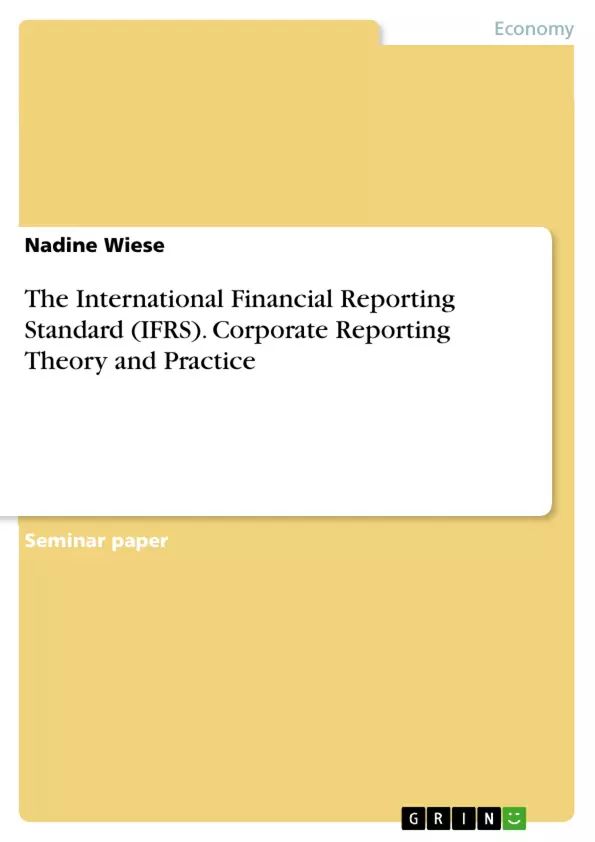In this report the International Financial Reporting Standard (IFRS) for Small and Medium-sized Entities (SMEs) is presented. It identifies that this new standard is required due to mainly smaller, non-listed companies prevailing. These entities currently use diverse national accounting standards and thus are not comparable. However, because of SMEs’ differing activities and stakeholders, existing IFRSs would not be appropriate so new standards are needed.
The IFRSs for SMEs are based on initial, full IFRSs but were reduced, simplified and adjusted to reduce the reporting burden that many small companies would suffer. All companies addressed are not publicly accountable, provide general purpose statements and approximately contain 50 employees. Which firms in detail will apply to these new standards is finalised by national jurisdictions. Nonetheless, there can be found some disadvantages. E.g. immense simplifications can result in insufficiently explained standards that can hardly be employed adequately.
Furthermore, four accounting events are revealed: goodwill impairment, cost method for associates, finance leases and research and development expenditures. All these show up differences compared to full IFRSs. The preparation of financial reports is facilitated and user interests are taken into consideration. However, alternatives can be suggested that perhaps are more appropriate for SMEs.
Finally, it is concluded that the IFRS for SMEs are well developed including advantageous adjustments that try to satisfy SMEs’ as well as their reports users’ needs. However, it becomes apparent that some revisions could be necessary to consequently truthfully allow the vast amount of smaller companies become globally comparable.
Inhaltsverzeichnis (Table of Contents)
- Executive Summary
- Introduction
- Reasons Why IFRSS for SMEs are Needed and What Benefits can be Expected
- Companies for which IFRSS for SMEs are assigned
- Cost-Benefit Evaluation
- Selected Recognition and Measurement Simplifications
- Goodwill Impairment
- Cost Method for Associated Companies
- Finance Leases
- Research and Development Expenditures
- Conclusion
- References
Zielsetzung und Themenschwerpunkte (Objectives and Key Themes)
This report presents the International Financial Reporting Standard (IFRS) for Small and Medium-sized Entities (SMEs). It examines the need for a new standard due to the prevalence of smaller, non-listed companies. These entities currently utilize diverse national accounting standards, hindering comparability. The report explores the rationale for developing IFRSS for SMEs, emphasizing the simplifications and adjustments made to the initial full IFRSS to reduce the reporting burden on smaller companies.
- The need for a new standard for SMEs due to the use of diverse national accounting standards.
- Simplifications and adjustments made to the initial full IFRSS to reduce the reporting burden on smaller companies.
- The benefits and drawbacks of the IFRSS for SMEs, including the potential for increased comparability and reduced reporting burden.
- The differences in accounting treatments between full IFRSs and the IFRSS for SMEs.
- The overall value of the IFRSS for SMEs in promoting international higher-quality financial statements.
Zusammenfassung der Kapitel (Chapter Summaries)
The report begins by outlining the purpose and background of the IFRSS for SMEs, emphasizing their focus on smaller, non-listed companies and their aim to provide a simplified and standardized set of accounting principles. The second chapter delves into the reasons for the need for these specialized standards, highlighting the challenges posed by diverse national standards and the specific needs of SMEs' stakeholders. The report then analyzes the cost-benefit evaluation of the IFRSS for SMEs, considering the potential advantages such as increased comparability and improved financial reporting quality while acknowledging potential disadvantages. Subsequent chapters explore specific areas where IFRSS for SMEs differ from full IFRSs, such as goodwill impairment, the cost method for associated companies, finance leases, and research and development expenditures. Each chapter examines these differences, their rationale, and their implications for SMEs. The report concludes by assessing the overall value of the IFRSS for SMEs and their potential to facilitate international higher-quality financial statements.
Schlüsselwörter (Keywords)
This report focuses on the International Financial Reporting Standard (IFRS) for Small and Medium-sized Entities (SMEs), examining its development, rationale, and implications. Key themes include the need for a standardized accounting framework for smaller, non-listed companies, the complexities and challenges of applying full IFRSs to SMEs, and the benefits and drawbacks of adopting a simplified and tailored standard. The report explores specific areas of difference between full IFRSs and the IFRSS for SMEs, including goodwill impairment, the cost method for associated companies, finance leases, and research and development expenditures.
- Citation du texte
- Nadine Wiese (Auteur), 2008, The International Financial Reporting Standard (IFRS). Corporate Reporting Theory and Practice, Munich, GRIN Verlag, https://www.grin.com/document/138215



